What Does It Mean to Sight in a Rifle?
Sighting in a rifle, often referred to as “zeroing,” involves adjusting the sights or scope of the rifle so that the point of aim aligns with the point of impact at a specific distance. This process is crucial for ensuring accuracy when shooting, particularly at longer ranges. Properly sighting in your rifle allows for better shot placement and increased confidence in your shooting abilities.
Importance of Sighting in a Rifle
- Accuracy: A well-sighted rifle will hit the target where you aim, which is critical for hunting and competitive shooting.
- Confidence: Knowing that your rifle is zeroed increases your confidence when taking shots.
- Safety: Accurate shooting reduces the risk of stray bullets, which can pose a danger to others.
- Consistency: Regularly sighting in your rifle ensures that it remains accurate over time, especially after transport or storage.
Equipment Needed for Sighting in a Rifle
Before you begin the sighting process, ensure you have the following equipment:
| Equipment | Purpose |
|---|---|
| Rifle | The firearm you will be sighting in. |
| Scope or Iron Sights | Optics or open sights that need to be adjusted. |
| Stable Shooting Rest | A bench, bipod, or sandbags to stabilize the rifle during shooting. |
| Targets | Paper or metal targets to aim at and assess accuracy. |
| Ammunition | Quality ammunition that is appropriate for your rifle. |
| Bore Sighter (optional) | A tool to help align the scope with the bore of the rifle. |
| Tools for Adjustments | Screwdriver or Allen wrench for tightening scope mounts. |
Step-by-Step Instructions for Sighting in a Rifle
Step 1: Prepare Your Rifle
- Clean the Rifle: Ensure your rifle is clean, including the barrel. A clean rifle will shoot more accurately than a dirty one.
- Check the Scope Mount: Ensure that your scope is securely mounted and that all screws are tightened. A loose scope can lead to inconsistent shot placement.
Step 2: Bore Sight the Rifle (Optional)
Bore sighting is a preliminary step that helps align the scope with the bore of the rifle.
- Remove the Bolt: For bolt-action rifles, remove the bolt to look down the barrel.
- Align the Bore: Aim the rifle at a target about 25 yards away and adjust the scope reticle to align with the target as seen through the bore.
- Secure the Rifle: Use a stable rest to prevent movement while making adjustments.
Step 3: Choose the Right Distance to Sight In
- Start at 25 or 50 Yards: For beginners, it’s often easier to start sighting in at a closer distance. Once you have a good zero at this range, you can adjust for longer distances.
Step 4: Set Up Your Shooting Position
- Use a Stable Rest: Place your rifle on a shooting bench or use sandbags to stabilize it.
- Position Yourself: Ensure you are comfortable and that your body is positioned correctly behind the rifle.
Step 5: Fire Initial Shots
- Fire a Group: Shoot a group of 3-5 shots at the target without making adjustments to see where the bullets are impacting.
- Observe Impact: Note where the group is hitting in relation to your point of aim.
Step 6: Make Adjustments
- Adjust the Scope: Based on the impact of your shots, make small adjustments to the windage (horizontal) and elevation (vertical) settings on your scope.
- Windage: Adjust left or right based on where the group is hitting.
- Elevation: Adjust up or down based on the vertical placement of the group.
- Follow the Rule of Thumb: Generally, 1 click on the scope adjustments equals about 1 inch at 100 yards. Adjust accordingly based on your distance.
Step 7: Shoot Another Group
- Fire Again: After making adjustments, shoot another group of 3-5 shots.
- Evaluate: Check the new group’s placement and see if further adjustments are needed.
Step 8: Repeat as Necessary
Continue to shoot groups and make adjustments until you achieve a satisfactory zero. This process may take several iterations, so be patient.
Step 9: Confirm Zero at Longer Distances
Once you have a solid zero at 25 or 50 yards, move to your desired distance (e.g., 100 yards) and repeat the process to confirm your zero at that range.
Tips for Successful Sighting In
- Be Patient: Sighting in a rifle can take time. Rushing can lead to mistakes.
- Allow the Barrel to Cool: After several shots, let the barrel cool to prevent overheating, which can affect accuracy.
- Use Quality Ammunition: Consistent ammunition will yield better results.
- Consider Environmental Factors: Wind and temperature can affect bullet trajectory. Be aware of these factors when shooting.
- Document Your Adjustments: Keep track of the adjustments you make for future reference.
Common Mistakes to Avoid
- Chasing Single Holes: Don’t make adjustments after every shot. Instead, shoot groups to get a better idea of your rifle’s performance.
- Neglecting the Basics: Ensure your rifle is clean and your scope is properly mounted before sighting in.
- Ignoring the Environment: Always consider wind and other environmental factors that can affect your shots.
- Not Using a Stable Rest: A stable shooting position is crucial for accurate shooting.
FAQ Section
What does it mean to sight in a rifle?
Sighting in a rifle means adjusting the sights or scope so that the bullet hits the intended target at a specific distance.
How far should I sight in my rifle?
It is common to sight in at 25 or 50 yards for beginners, then confirm zero at longer distances like 100 yards.
What tools do I need to sight in a rifle?
You will need a rifle, scope or iron sights, stable shooting rest, targets, ammunition, and possibly a bore sighter.
How do I know if my rifle is properly sighted in?
Your rifle is properly sighted in when the point of aim aligns with the point of impact at your chosen distance.
How often should I sight in my rifle?
You should sight in your rifle whenever you change ammunition, after transporting it, or if you notice a change in accuracy.
Can I sight in my rifle without a shooting range?
Yes, you can sight in your rifle in a safe outdoor area, provided you have a suitable backstop and follow all safety protocols.
What should I do if my shots are inconsistent?
Check your scope mounts, ensure your rifle is clean, and verify that you are using quality ammunition. If problems persist, consider consulting a professional.
Conclusion
Sighting in a rifle is a fundamental skill that every shooter should master. By following the steps outlined in this guide and practicing regularly, you can ensure that your rifle is accurately zeroed, leading to improved shooting performance and confidence. Remember to be patient and methodical in your approach, and always prioritize safety when handling firearms.For more information on rifle safety and shooting techniques, you can refer to the Wikipedia page on Firearm Safety.



